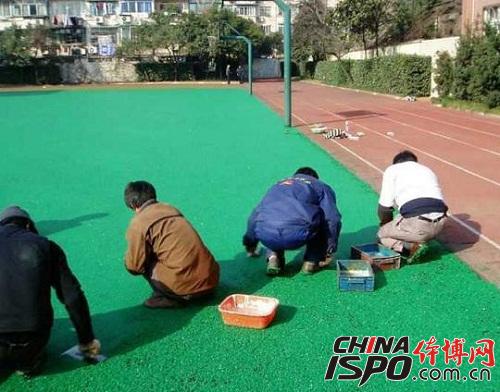When a plastic running track requires renovation, there are typically two main scenarios. The first is when the track has reached the end of its service life and can no longer provide safe and effective use for athletes or users. Continuing to use it could pose risks to health and safety. The second scenario involves damage caused by improper usage, such as heavy impacts, accidental burns from cigarette butts, or damage from sharp objects. These issues can compromise the integrity of the track and require timely intervention.

The process of renovating a plastic track involves several key steps, starting with a thorough site inspection to assess the extent of the damage. Minor issues may only require resurfacing, while more severe damage might necessitate restoring the base layer. Here’s an overview of the renovation procedure:
**First, site cleaning**
Before any work begins, the area must be thoroughly cleaned to ensure proper adhesion of the new surface. This includes removing dirt using a broom and hair dryer, scraping off raised areas with a spatula, washing away soil with high-pressure water, and clearing debris from nearby plants. It's also important to restrict access to the site during this phase to maintain cleanliness and prevent further damage.
**Second, repair**
Once the site is clean, the next step is to inspect and repair any damaged areas. This may involve removing delaminated sections, sealing cracks, and applying a special adhesive before filling in the gaps. The materials must be mixed carefully, following precise ratios and time constraints based on environmental conditions. Proper mixing ensures that the final product is durable and long-lasting.
**Third, full back cover**
After repairs, the entire surface is coated with a new layer of material. This step includes setting up warning signs, protecting surrounding facilities, preparing tools, and ensuring all materials are ready for application. The mixture is then sprayed evenly across the surface, allowing it to dry before proceeding to the final stage.
**Fourth, surface preparation**
This stage involves planning the layout, securing power and water sources, and organizing materials and tools. All equipment is checked to ensure it functions properly, and the work area is kept clean and organized to avoid contamination.
**Fifth, surface coating**
The final layer of material is applied using specialized sprayers. The process includes measuring the correct amounts, mixing the components, and spraying the surface in controlled layers to ensure even coverage. Each layer should be at least 1.5mm thick, and the application must be done continuously to avoid unevenness or missed spots.
**Sixth, positioning and marking**
After the surface is fully coated, the track is marked according to international standards. This includes rechecking original markings, cleaning the surface, and applying white lines using high-quality polyurethane paint. The lines must be clear, uniform, and free of seams or irregularities.
**Seventh, handover and protection**
Before leaving the site, the finished track is protected to prevent damage. A manual is also provided to the client, detailing maintenance instructions and safety guidelines. Once completed, the renovated track is ready for use after 7–10 days of drying and curing.
Renovating a plastic track is a detailed and technical process, requiring skilled workers and careful planning. By following these steps, the track can be restored to its original condition, ensuring safety, performance, and longevity for years to come.
Cotton Muslin Cloth
Makeup Remove Cotton Cloth,Cotton Makeup Remove Cloth,Makeup Remover Cloth,Face Cleansing Cloths
Fashiontex Industries Ltd , https://www.fashiontexjs.com